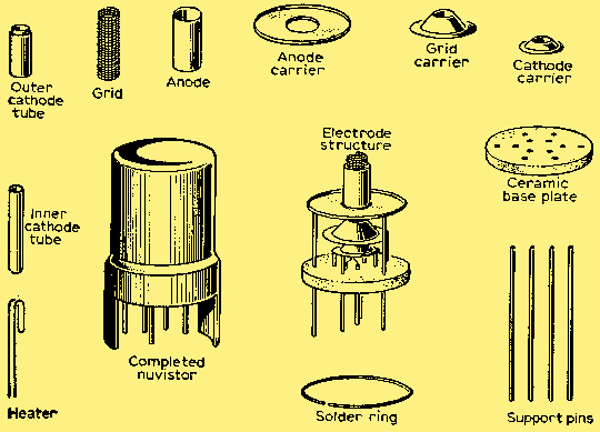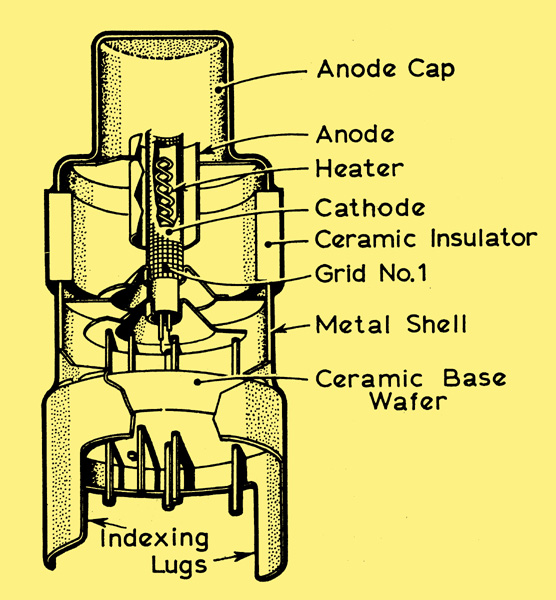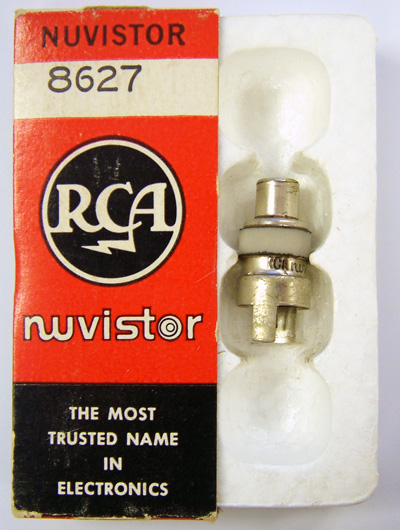|

Construction of a Mullard Nuvistor
This type of valve is intermediate between valves of normal construction and disc-seal or stacked ceramic. The electrodes are of cylindrical shape but smaller than those generally employed and are rigidly supported from one end by a tripod-like structure on a ceramic base.
The supports are continuations of the pins which are sealed through the base. No use is made of mica or glass supports or spacers. This construction produces rugged and efficient valves having low leakage and low microphony. Because the structure is so small the capacitance between electrodes and the lead inductance is low, resulting in a good performance and low noise at VHF.
By the late 1950s the transistor had clearly shown that it was capable of replacing valves in many applications. RCA developed the Nuvistor as one of the last major advances in valve technology and its size at little more than the size of a typical transistor of the day was deliberate. The first Nuvistor was developed in 1959. All Nuvistors had 6.3 Volt heaters, a special base and low inter-electrode capacitance. The majority were triodes but a few were tetrodes.
Nuvistors were used extensively in test equipment produced in the 1960s and '70s by companies such as Tektronix and Hewlett Packard. Their application was mainly in high-impedance cathode-follower vertical and trigger input circuits, and also Miller timebases. They could also be found as the first stage in the vertical or Y amplifiers of high-end oscilloscopes. A Nuvistor was used in the plug-in wideband preamplifier module available for the Hewlett Packard 5245L 50 MHz counter-timer of the 1960s
They were also used in receiver front-ends, where they provided good performance coupled with low noise up into the VHF and UHF frequency ranges.
In 1965, Philips produced the first of a range of colour cameras which would revolutionise the industry. The PC60, unlike its counterparts from rival companies, was totally transistorised with the exception of the three Plumbicon tubes and the Nuvistor in each of the three head amplifiers.
Although chosen for its low noise characteristic, the Nuvistor produced only modest gain and as a result the earlier versions of the PC60 were somewhat insensitive. By way of comparison, broadcast TV monochrome cameras of the day required 75-100 foot candles of studio illumination, whereas the PC60 needed 175 foot candles to produce decent quality pictures!
Developments in transistor technology were moving rapidly, and by 1968/9 the Nuvistor's place in the camera head amplifier was taken over by the field effect transistor.
In 1965, Hallicrafters used the 13CW4 Nuvistor as an RF amplifier in their SR42 and SR46 2m and 6m amateur-band rigs.
Typical devices are: 7586 The first one released, a medium μ triode. 7587 A sharp cut-off tetrode. 7895 As 7586 but with higher μ. 8056 A triode for low anode voltages. 8058 A triode with anode cap & grid on shell designed for UHF performance. 6CW4 A high μ triode often used in television receivers of the early to mid 1960s period. 6DS4 A remote cut-off variant of the 6CW4. 6DV4 A medium μ triode designed as UHF oscillator. In some production runs the case of the 6DV4 was gold plated.

Construction of a power Nuvistor such as the 8627 as below

|